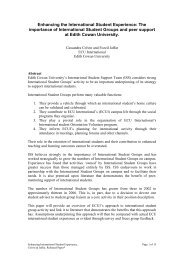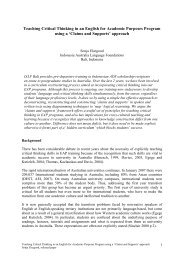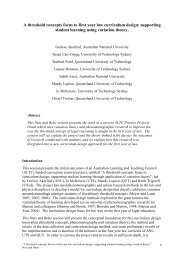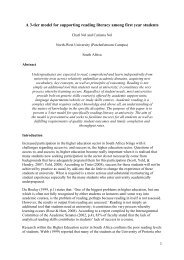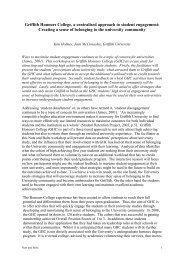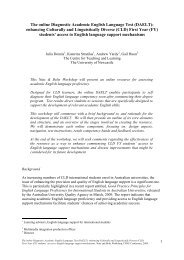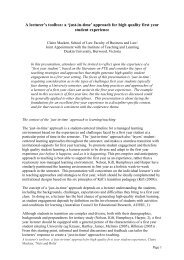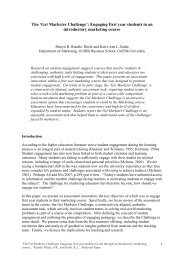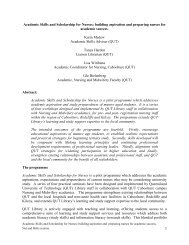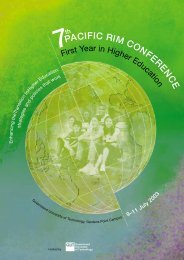Keynote Presentation
Keynote Presentation
Keynote Presentation
Create successful ePaper yourself
Turn your PDF publications into a flip-book with our unique Google optimized e-Paper software.
Towards a southern theory of<br />
higher education<br />
Trevor Gale, National Centre for Student Equity in Higher Education<br />
1
Overview<br />
Understanding equity<br />
Responding to equity targets<br />
Improving the student learning<br />
experience<br />
Knowing and ways of knowing<br />
2
Southern Theory<br />
... calls attention to the centre-periphery relations in<br />
the realm of knowledge … [Connell] use[s] the term<br />
ʻSouthernʼ not to name a sharply bounded category of<br />
states or societies, but to emphasise relations –<br />
authority, exclusion and inclusion, hegemony,<br />
partnership, sponsorship, appropriation – between<br />
intellectuals and institutions in the metropole and<br />
those in the world periphery. (Connell 2007: viii-ix)<br />
3
The record so far<br />
4
How can we account for differences<br />
between equity groups?<br />
How can we, indeed should we, account<br />
for differences within equity groups?<br />
How confident can we be that we are<br />
measuring what we claim to be<br />
measuring?<br />
5
Low SES we can trust<br />
Socioeconomic status is a concept that is defined by its context;<br />
we need to avoid measures that ʻcontext-stripʼ individuals,<br />
effectively discounting their social and cultural contexts, which<br />
contribute to who they are;<br />
Because of the range of circumstances that constitute<br />
socioeconomic status, better statistical measures need to involve<br />
a combination rather than rely on one single measure;<br />
The combination of social, cultural and economic circumstances<br />
that define socioeconomic status means that any statistical<br />
representation needs to be treated as indicative rather than<br />
prescriptive; statistical measures of social and cultural issues are<br />
always approximations.<br />
6
Success!<br />
20% not 25%<br />
Higher education is not all the same<br />
High and Low SES are not evenly<br />
spread across the country<br />
7
The research evidence<br />
10
2009-10<br />
$m<br />
2010-11<br />
$m<br />
2011-12<br />
$m<br />
2012-13<br />
$m<br />
4 yr total<br />
$m<br />
Partnerships activities 7 21 36 44 108<br />
Enrolment loading 21 64 108 132 325<br />
Total funding to support<br />
low SES participation*<br />
$433<br />
11
Low SES students need support<br />
12
Go8 March (2009) Newsletter <br />
http://www.go8.edu.au/index.php?option=com_content&task=view&id=221&Itemid=180<br />
13
Access without support is not<br />
opportunity (Tinto)<br />
Opportunity confined to support is not<br />
equity<br />
14
Support as disciplining<br />
Low SES students are positioned as a potential<br />
threat to academic standards<br />
Student support is the mechanism for assuring that<br />
academic standards are maintained<br />
Support tends to act on students, to fix their short<br />
comings so they meet the academic standards<br />
required to participate in the mainstream of higher<br />
education<br />
Maintaining standards of quality and excellence<br />
15
A southern theory of higher education<br />
First and foremost, student learning environments and<br />
experiences are such that students are appreciated<br />
for who they are and for how they identify themselves;<br />
Second, there are opportunities in these environments<br />
and experiences for all students to make contributions<br />
as well as to develop their understandings and skills;<br />
Third, all students are provided with genuine<br />
opportunities to shape how their learning<br />
environments and experiences are structured.<br />
16
The international student case<br />
17
In-class-ive curriculum<br />
Different understandings of<br />
knowledge<br />
Relations between<br />
pure and applied<br />
knowledge<br />
Decompartmentalisati<br />
on of knowledge,<br />
through discipline(s)<br />
Unofficial sites of<br />
learning<br />
Different ways of knowing<br />
learning through<br />
activity<br />
problem based<br />
learning<br />
practice-based<br />
learning<br />
narrative<br />
18
Pure vs Applied<br />
increasingly, knowledges and skills which could once only be<br />
acquired ʻon the job,ʼ and which had no existence outside of<br />
their use or application, are now deemed to have a formal<br />
component, which is a knowledge like any other; their practical<br />
component now presupposes a mastery of the theory of which<br />
the practical component is the application. Nursing and tourism<br />
become university subjects, knowledges which have to be<br />
learned in such a way that the students can draw upon their<br />
stock of formal knowledge and ʻapplyʼ it according to context.<br />
(Seth 2007: 38-39)
knowing and ways of knowing<br />
Funds of knowledge – value placed on a<br />
variety of knowledges<br />
Funds of pedagogy – value placed on a<br />
variety of ways of knowing / learning<br />
Fusion of funds – creating spaces in<br />
curriculum design and pedagogy for different<br />
knowledges to make contributions and for<br />
those contributions to be valued<br />
20
Creating spaces in HE for students<br />
is about<br />
involves<br />
students having opportunities<br />
to express what they know<br />
student understandings<br />
being respected and valued <br />
university knowledge<br />
complementing and<br />
challenging what students<br />
know<br />
studentsʼ knowledge<br />
complementing and<br />
challenging what others<br />
(including universities) know<br />
21<br />
Reposition lecturers,<br />
peers, academic<br />
literature, fieldwork, etc as<br />
resources for studentsʼ<br />
learning<br />
Repositioning disciplines,<br />
traditions, etc as<br />
resources to aid<br />
understanding of issues,<br />
problems, themes, etc.
Conclusion<br />
Itʼs about the numbers<br />
Itʼs about the support<br />
Itʼs about creating places and spaces<br />
of higher education<br />
22



